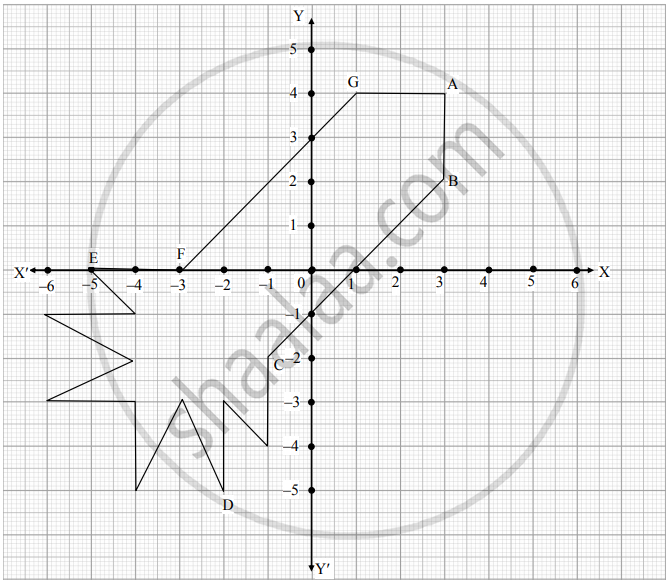Advertisements
Advertisements
प्रश्न
Show that the points A(5, 6), B(1, 5), C(2, 1) and D(6,2) are the vertices of a square.
उत्तर
The distance d between two points `(x_1,y_1)` and `(x_2,y_2)` is given by the formula
`d = sqrt((x_1 - x_2)^2 + (y_1 - y_2)^2)`
In a square all the sides are equal to each other. And also the diagonals are also equal to each other.
Here the four points are A(5,6), B(1,5), C(2,1) and D(6,2).
First, let us check if all the four sides are equal.
`AB = sqrt((5 - 1)^2 + (6 - 5)^2)`
`= sqrt((4)^2 + (1)^2)`
`= sqrt(16 + 1)`
`BC = sqrt17`
`CD = sqrt((2 - 6)^2 + (1 - 2)^2)`
`= sqrt((-4)^2 + (-1)^2)`
`= sqrt(1 + 16)`
`CD = sqrt17`
`AD = sqrt((5 - 6)^2 + (6 - 2)^2)`
`= sqrt((-1)^2 + (4)^2)`
`= sqrt(1 + 16)`
`AD = sqrt(17)`
Here, we see that all the sides are equal, so it has to be a rhombus.
Now let us find out the lengths of the diagonals of this rhombus.
`AC = sqrt((5 - 2)^2 + (6 - 1)^2)`
`sqrt((3)^2 + (5)^2)`
`= sqrt(9 + 25)`
`AC = sqrt34`
`BD = sqrt((1 - 6)^2 + (5 - 2)^2)`
`= sqrt((-5)^2 + (3)^2)`
`= sqrt(25 + 9)`
`BD = sqrt(34)`
Now since the diagonals of the rhombus are also equal to each other this rhombus has to be a square.
Hence we have proved that the quadrilateral formed by the given four points is square.
APPEARS IN
संबंधित प्रश्न
On which axis do the following points lie?
P(5, 0)
Find the distance between the following pair of points:
(a, 0) and (0, b)
The coordinates of the point P are (−3, 2). Find the coordinates of the point Q which lies on the line joining P and origin such that OP = OQ.
In Fig. 14.36, a right triangle BOA is given C is the mid-point of the hypotenuse AB. Show that it is equidistant from the vertices O, A and B.

We have a right angled triangle,`triangle BOA` right angled at O. Co-ordinates are B (0,2b); A (2a, 0) and C (0, 0).
If the points A (a, -11), B (5, b), C (2, 15) and D (1, 1) are the vertices of a parallelogram ABCD, find the values of a and b.
Show that the following points are the vertices of a square:
A (0,-2), B(3,1), C(0,4) and D(-3,1)
Show that the points A(2,1), B(5,2), C(6,4) and D(3,3) are the angular points of a parallelogram. Is this figure a rectangle?
If the vertices of ΔABC be A(1, -3) B(4, p) and C(-9, 7) and its area is 15 square units, find the values of p
If the point A(0,2) is equidistant from the points B(3,p) and C(p, 5), find p.
The co-ordinates of point A and B are 4 and -8 respectively. Find d(A, B).
The abscissa of a point is positive in the
If the point P (m, 3) lies on the line segment joining the points \[A\left( - \frac{2}{5}, 6 \right)\] and B (2, 8), find the value of m.
Write the coordinates of a point on X-axis which is equidistant from the points (−3, 4) and (2, 5).
If the mid-point of the segment joining A (x, y + 1) and B (x + 1, y + 2) is C \[\left( \frac{3}{2}, \frac{5}{2} \right)\] , find x, y.
The line segment joining the points A(2, 1) and B (5, - 8) is trisected at the points P and Q such that P is nearer to A. If P also lies on the line given by 2x - y + k= 0 find the value of k.
Find the coordinates of point A, where AB is a diameter of the circle with centre (–2, 2) and B is the point with coordinates (3, 4).
A point both of whose coordinates are negative will lie in ______.
The perpendicular distance of the point P(3, 4) from the y-axis is ______.
Statement A (Assertion): If the coordinates of the mid-points of the sides AB and AC of ∆ABC are D(3, 5) and E(–3, –3) respectively, then BC = 20 units.
Statement R (Reason): The line joining the mid-points of two sides of a triangle is parallel to the third side and equal to half of it.
Ryan, from a very young age, was fascinated by the twinkling of stars and the vastness of space. He always dreamt of becoming an astronaut one day. So, he started to sketch his own rocket designs on the graph sheet. One such design is given below :

Based on the above, answer the following questions:
i. Find the mid-point of the segment joining F and G. (1)
ii. a. What is the distance between the points A and C? (2)
OR
b. Find the coordinates of the points which divides the line segment joining the points A and B in the ratio 1 : 3 internally. (2)
iii. What are the coordinates of the point D? (1)
